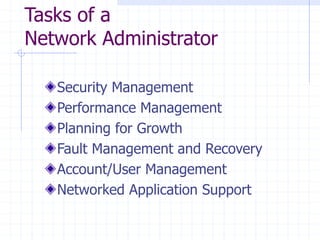INTRODUCTION.ppt
- 1. What is Network Administration ?? Network administration can be defined as: âbranch of engineering that concerns the operational management of human-computer systemsâ [Burgess Ch 1] A network administrator has different roles [Stallings page 3] âĒControlling corporate strategic assets âĒControlling complexity âĒImproving service âĒBalancing various needs âĒReducing downtime âĒControlling costs
- 2. Why do we need Network administration at first ??
- 3. âF C A P Sâ âĒ Fault Management âĒ Configuration & Name Management âĒ Account Management âĒ Performance Management âĒ Security Management The core management areas
- 4. Fault management The facilities that enable the ïŪ detection, ïŪ isolation, and ïŪ correction of abnormal operation of the OSI environment.
- 5. Configuration and Name Management The services and facilities that âĒ control âĒ identify âĒ collect and provide data to clients and managed objects, so assisting in continuous operation of interconnection services.
- 6. OSI - Account Management The facilities that enable charges to be established for the use of managed objects and costs to be identified for the use of those managed objects.
- 7. OSI - Performance Management The Facilities needed to evaluate ïŪ Behaviour of managed objects ïŪ Effectiveness of communication activities
- 8. OSI - Security Management Address those aspects of OSI security essential to: ïŪ operate OSI network management correctly and ïŪ to protect managed objects
- 9. Definitions?? How does Network Administration work in Practice? Letâs look at how Network Management is OrganisedâĶ
- 10. Network Hardware Applications Division of Labour Structure of Systems and Network Management Organisation
- 11. Corporate Networked Environments Have team(s) of specialists in various areas Well defined tasks ïŪ job descriptions In small networks usually one person ïŪ multi-skilled and multi-tasked In reality â often somewhere in betweenâĶ.
- 13. Tasks of a Network Administrator Security Management Performance Management Planning for Growth Fault Management and Recovery Account/User Management Networked Application Support
- 14. Security Management Firewalls Usernames Password control Resource Access Control
- 16. Planning for Growth A Network (or any organisation) is not static Growth means increased load on a network. This must be planned forâĶ. Systems eventually need replacement. This must be planned for â in advanceâĶ
- 17. Fault Management and Recovery Monitoring ïŪ Reporting status Testing ïŪ Fixes and Patches ïŪ Updates ïŪ Repairs ïŪ Change Management
- 18. Account / User Management Communication Facilities ïŪ Connection - Rental - Charges Hardware Usage ïŪ Lease - Rent - Hire Consumables Usage ïŪ Power, Paper, Media (Diskettes, CDsâĶ) Software Usage ïŪ Licensing, ïŪ Tolls, ïŪ Application usage
- 19. Account / User Management Accounts are Managed for: ïŪ Intrusion detection / prevention ïŪ Charging for Services ïŪ Legal protection of the Organisation
- 20. Networked Application Support Client / Server systems support Internet support Server support ïŪ Applications and Hardware Helpdesk ïŪ Trouble report / Bug fixes ïŪ Printing ïŪ eMail
- 21. How to be a Sys/Net Admin (yet another Job DescriptionâĶ) Learn Operating System basics eg Unix Learn shell utilities and script programming Learn how to Install and Configure OS Learn DNS and Bind Learn TCP/IP networking Learn NFS and NIS (or equivalentâĶ) Learn about system tuning and accounting Learn Compile and Link (eg C and make)
- 22. Goals of System/Network Administration Put together a network of computers Get them running Keep them running (despite UsersâĶ.) Provide a Service to Users Requires skills of ïŪ Mechanic ïŪ Sociologist ïŪ Researcher
- 23. Challenges of System/Network Administration Systems or Network Administration is more than just installing computers or networks. It is about planning and designing an efficient community of computers that allow users to get their jobs done.
- 24. Challenges of Administration Design Logical, Efficient networks Easily deploy & update many machines Decide what services are needed ïŪ know the business tasks & customers Plan and implement adequate security Provide comfortable User environment Be able to fix errors and problems Keep track of & be able to use knowledge
- 26. PRACTICE Convention or The Best Solution PRACTICE = âHow things are done hereâ Have you ever wonderedâĶ Why are things done in certain ways? Which way is best? Usually itâs because: Someone did it once, and everyone copied without really thinking about it People have thought much about it and this really is the best wayâĶ An arbitrary choice was made, and it is now a matter of convention
- 27. Comparison of System/Network Management Styles Fire-Fighting ïŪ Managing by responding to situations when they happen (Reactive) Preventative management ïŪ Monitor network and make repairs and changes before problems appear (Proactive) These are two opposite extremes. Most real managers combine both.
- 28. Fire-Fighting Investigate the Fault or Problem ïŪ Isolate the problem and identify/define it ïŪ Use tests and tools to diagnose the problem ïŪ Solve the problem and document the solution Prioritize multiple problems
- 29. Preventative Management The Good Circle management cycle
- 30. Preventative Management Techniques Capacity Planning Simulation and Testing ïŪ load generators ïŪ Benchmarks Performance Monitors and System Tuning ïŪ Network analysis and modelling ïŪ Load balancing ïŪ Hardware upgrades
- 31. Management method and Cost
- 32. Information about Network Administration The KnowledgeâĶ. What is it? Where is it? How do we get it?
- 33. Sources of Information for System/Network Administrators Manuals and Online Documentation World Wide Web RFCs, FYIs, IENs News groups, Discussion lists, WebLogs Meetings and Seminars ïŪ SAGE/Usenix, Novell Brainshare, Microsoft TechNet/TechEd How-To books
- 34. (END) No Tutorials in Week 1.
![What is Network Administration ??
Network administration can be defined as:
âbranch of engineering that concerns the
operational management of human-computer
systemsâ [Burgess Ch 1]
A network administrator has different roles
[Stallings page 3]
âĒControlling corporate strategic assets
âĒControlling complexity
âĒImproving service
âĒBalancing various needs
âĒReducing downtime
âĒControlling costs](https://image.slidesharecdn.com/introduction-230725122430-631ec0cf/85/INTRODUCTION-ppt-1-320.jpg)
































